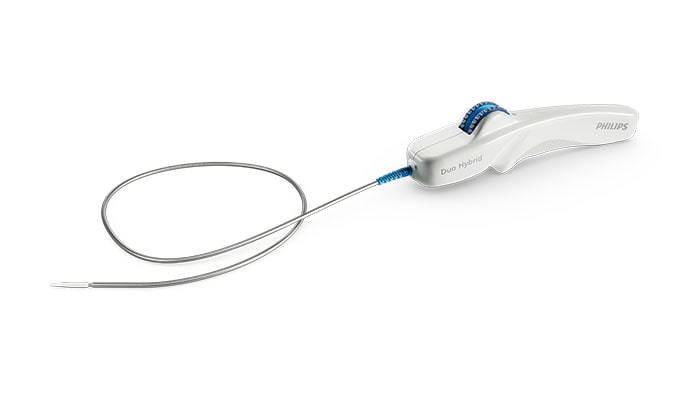Philips launches Duo Venous Stent System for treatment of symptomatic venous outflow obstruction
Sanger Heart & Vascular Institute, Atrium Health, treated the first patient with the new implantable medical device following FDA premarket approval
Jun 12, 2024 | 4 minute read
Amsterdam, the Netherlands – Royal Philips (NYSE: PHG, AEX: PHIA), a global leader in health technology, today announced the first implant of the Duo Venous Stent System, an implantable medical device indicated to treat symptomatic venous outflow obstruction in patients with chronic venous insufficiency (CVI), following premarket approval (PMA) from the U.S. Food and Drug Association (FDA).

On June 11, Dr Erin Murphy – vascular surgeon and director of the Venous and Lymphatic Program at the renowned Sanger Heart & Vascular Institute, Atrium Health, in Charlotte, N.C., and an investigator in the VIVID study, which contributed to the device’s FDA approval – successfully used the Duo Venous Stent System for the first time outside of a clinical trial.
Impacting 25 million people globally [1], deep venous disease results from venous thromboembolism, a condition that occurs when a blood clot forms in the vein [2]. It is the third most common cardiovascular disease [2]. Deep venous anatomy and obstructions can present a multitude of complexities and mechanical challenges.
Engineered for the unique demands of venous anatomy and obstructions, the Duo Venous Stent System is comprised of two stents – Duo Hybrid and Duo Extend – of various sizes. Duo Hybrid has a distinct integrated design that combines multiple zones of differing mechanical properties into a single stent [3]. For long lesions, Duo Extend smoothly overlaps with the Duo Hybrid to extend therapy. These two stents are designed to work together and minimize the risk of stent fracture and corrosion, while providing an option to stent within caudal veins with smaller diameters [3].
Duo is the first stent that offers a differential design for the challenges of venous anatomy – a focal area that withstands the forces of compression as well as the flexibility to accommodate curvature of the vessel.
“Duo is the first stent that offers a differential design for the challenges of venous anatomy – a focal area that withstands the forces of compression as well as the flexibility to accommodate curvature of the vessel,” said Dr Kush Desai, a highly regarded Interventional radiologist and associate professor of Radiology, Surgery and Medicine at Northwestern University in Chicago, as well as a leading enroller and investigator for the VIVID study.
“Consequently, Philips is well positioned to support CVI treatment by offering a robust portfolio of medical technology that includes both intravascular ultrasound and a differentiated venous stenting system.”
VIVID study
The VIVID study is a global, prospective, multi-center, single-arm, non-blinded clinical trial conducted in the U.S. and Poland, evaluating the safety and efficacy of the Philips Duo Venous Stent System in the treatment of nonmalignant iliofemoral occlusive disease. It enrolled 162 subjects at 30 centers with three patient populations – non-thrombotic iliac vein lesion (NIVL), post-thrombotic syndrome (PTS) and acute deep vein thrombosis (aDVT). The VIVID study is now in 36-month follow-up and upon FDA PMA approval transitioned from an investigational device exemption (IDE) study to a post-approval study (PAS): NCT04580160.
The VIVID study met all of its primary safety and efficacy performance goals.
In addition, quality of life and venous functional assessments that were performed in the VIVID study – including Clinical-Etiology-Anatomy-Pathophysiology (CEAP), Venous Clinical Severity Score (VCSS), Villalta, EQ-5D-3L and VEINES scores – showed sustained improvements compared to baseline at 12 months.
“The VIVID study’s 12-month results demonstrate the safety and efficacy of the Duo Venous Stent System in the treatment of chronic venous insufficiency, a vascular condition affecting millions of people worldwide,” said principal investigator Dr Mahmood Razavi, M.D., an interventional radiologist with St. Joseph Vascular in Orange County, Calif.
“Duo represents a meaningful addition to the tools that clinicians can use to treat CVI patients,” Dr Razavi added, “especially when used in conjunction with intravascular ultrasound, or IVUS. Ultimately, the new device promises to enable excellent clinical outcomes and drive significant quality of life improvements.”
The VIVID study was the first clinical trial to mandate IVUS use to aid in lesion assessment and stent sizing prior to device implantation. According to prior published research, IVUS supports accurate diagnosis of venous disease and has been shown to change 57% of treatment plans compared to venography alone [4]. Led by Philips, intravascular imaging is used in more than 70% of venous stent procedures [5].
“The launch of the Duo Venous Stent System represents another step forward in achieving our aspiration to innovate interventional procedures with advanced medical technology,” said Heather Hudnut Page, Vice President and Business Leader of Peripheral Vascular at Philips. “In this context, we look forward to bringing the combined offering of intravascular ultrasound and Duo to the interdisciplinary teams – from vascular surgeons to interventional radiologists and interventional cardiologists – who share our overarching goal of enhancing patient care.”
Regulatory disclosures
Developed by Vesper Medical, Inc., a wholly owned subsidiary of Philips, the Duo Venous Stent System is being marketed under the Philips brand. Its FDA approval order, along with related regulatory information, can be found here: PMA approval for Duo Venous Stent System.
Caution: Federal law restricts this device to sale by or on the order of a licensed healthcare practitioner.
Sources [1] Market Model Sources- DVD: 1 US Physician Quant Survey- Leveraged for NIVL prevalence assumption as ~25% of Symptomatic DVD 2 Thrombosis: a major contributor to the global disease burden. J Thromb Haemost 2014; 12: 1580–90. - Leveraged for DVT incidence in some countries (ex. EU5) 3 DRG VTE Epidemiology Reports- Leveraged for DVT incidence in some countries 4 Inari Medical presentation and Khan, SR, Arch Intern Med 2004- Leveraged for assumption of PTS.
[2] Scheres LJJ, Lijfering WM, Cannegieter SC. Current and future burden of venous thrombosis: Not simply predictable. Res Pract Thromb Haemost. 2018 Apr 17;2(2):199-208. doi: 10.1002/rth2.12101. PMID: 30046722; PMCID: PMC6055567.
[3] Data on file: D062749
[4] Gagne PJ, Tahara RW, Fastabend CP, et al. Venography versus intravascular ultrasound for diagnosing and treating iliofemoral vein obstruction. J Vasc Surg Venous Lymphat Disord. 2017;5:678-687.
[5] Divakaran S, Meissner MH, Kohi MP, et al. Utilization of and Outcomes Associated with Intravascular Ultrasound during Deep Venous Stent Placement among Medicare Beneficiaries. J Vasc Interv Radiol. 2022;33(12):1476-1484.e2. doi:10.1016/j.jvir.2022.08.018










